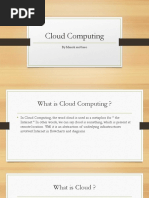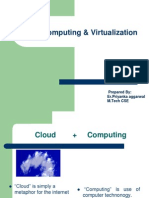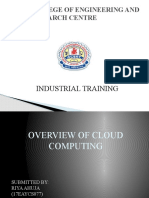Cloud Computing
Uploaded by
Debashish RoyCloud Computing
Uploaded by
Debashish RoyCloud Computing
Cloud computing is an approach to offering IT services. Cloud computing
makes use of products such as the virtualization products but also uses
products built specifically to enable cloud features. However, cloud computing
is not just a set of products to be implemented; instead, it is a way of offering
IT services.
NIST (National Institute of Standards and Technology has a good definition of cloud
computing:
• On-demand self-service: a customer should be able to get a service
automatically, without having to wait for a human to provide it for her. The
customer should also be able to terminate the service by herself.
• Broad network access: the service should be available using a variety of different
platforms including computers, tablets, smartphones. We should also be able to
reach the service using different connections, including the Internet or private
WAN connections.
• Resource pooling: the cloud provider should not assign fixed resources to the
service but it has to be dynamic. For example, when a website suddenly receives a
lot of traffic, multiple web servers should be created automatically so that we can
deal with the incoming traffic.
• Rapid elasticity: to the customer, the resources should look to be unlimited. For
example, there are some cloud backup providers that you can use for remote
backups. You pay for the service and behind the scenes, they will take care that
there is enough storage space for you to upload your files to. It doesn’t matter if
you upload 1 GB or 100 TB.
• Measured service: the cloud provider measures all resource usage for billing and
transparency.
Services model
Instead of buying a product, we pay for a service. When we talk about cloud computing,
we use the “as a service” terminology a lot. These three are the most common:
• (IaaS) Infrastructure as a service
• (PaaS) Platform as a service
• (SaaS) Software as a service
IaaS (Infrastructure as a service)
Iaas offers network infrastructure as a service. These are network
devices like virtual machines, routers, switches, firewalls, load balancers,
and storage.
You specify the amount of hardware performance/capacity to allocate to the
VM (number of virtual CPUs, amount of RAM, and so on)
SaaS (Software as a Service)
With Software as a Service (SaaS), the consumer receives a service with
working software. The cloud provider may use VMs, possibly many VMs, to
create the service, but those are hidden from the consumer. The cloud
provider licenses, installs, and supports whatever software is required. The
cloud provider then monitors performance of the application.
File storage services like Apple iCloud, Google Drive, Dropbox, and Box are all
SaaS offerings.
PaaS (Platform as a Service)
Platform as a Service (PaaS) is a development platform, prebuilt as a service. A
PaaS service is like IaaS in some ways. Both supply the consumer with one or
more VMs, with a configurable amount of CPU, RAM, and other resources.
A PaaS offering includes a set of development tools, and each PaaS offering has
a different combination of tools. PaaS VMs often include an integrated
development environment (IDE), which is a set of related tools that enables
the developer to write and test code easily.
Public Cloud
With a private cloud, the cloud provider and the cloud consumer are part of
the same company. With public cloud, the reverse is true: a public cloud
provider offers services, selling those services to consumers in other
companies. In fact, if you think of Internet service providers and WAN service
providers selling Internet and WAN services to many enterprises, the same
general idea works here with public cloud providers selling their services to
many enterprises.
The largest cloud providers are:
• Amazon AWS
• Microsoft Azure
• IBM
• Google Cloud Platform
Private Cloud (On-Premise)
Private cloud creates a service, inside a company, to internal customers.
To create a private cloud, an enterprise often expands its IT tools (like
virtualization tools), changes internal workflow processes, adds additional
tools, and so on
As some examples, consider what happens when an application developer at a
company needs VMs to use when developing an application. With private
cloud, the developer can request those VMs and those VMs automatically start
and are available within minutes, with most of the time lag being the time to
boot the VMs. If the developer wants many more VMs, he can assume that the
private cloud will have enough capacity, and new requests are still serviced
rapidly. And all parties should know that the IT group can measure the usage of
the services for internal billing
You might also like
- Pioneer - vsx-44 824-k 1024-k 1029-k Service Manual100% (1)Pioneer - vsx-44 824-k 1024-k 1029-k Service Manual81 pages
- Cloud Computing 101 Cloud Computing 101No ratings yetCloud Computing 101 Cloud Computing 10116 pages
- Chapter 1 Introduction to Cloud Computing (1)No ratings yetChapter 1 Introduction to Cloud Computing (1)53 pages
- Google Cloud Platform: Introduction To Cloud ComputingNo ratings yetGoogle Cloud Platform: Introduction To Cloud Computing11 pages
- Cloud Computing: Panizal, Sevillena, Soberano, VillegasNo ratings yetCloud Computing: Panizal, Sevillena, Soberano, Villegas52 pages
- Arya College of Engineering and Research Centre: Industrial TrainingNo ratings yetArya College of Engineering and Research Centre: Industrial Training28 pages
- Loud Computing: Download Now: Speech-to-Text Services: AWS vs. Microsoft vs. GoogleNo ratings yetLoud Computing: Download Now: Speech-to-Text Services: AWS vs. Microsoft vs. Google26 pages
- Cloud Computing Interview Questions and AnswersNo ratings yetCloud Computing Interview Questions and Answers13 pages
- Cloud Computing Made Simple: Navigating the Cloud: A Practical Guide to Cloud ComputingFrom EverandCloud Computing Made Simple: Navigating the Cloud: A Practical Guide to Cloud ComputingNo ratings yet
- Restaurant Reservation Website DocumentationNo ratings yetRestaurant Reservation Website Documentation30 pages
- Grand Theft Auto Community Update - Rockstar GamesNo ratings yetGrand Theft Auto Community Update - Rockstar Games1 page
- 02 BNPP HCM - RFP For DC Tender PackageNo ratings yet02 BNPP HCM - RFP For DC Tender Package55 pages
- Sophos Managed Detection and Response DsNo ratings yetSophos Managed Detection and Response Ds4 pages
- The Role of Dynamic Capabilities in Responding To Digital Disruption A Factor-Based Study of The Newspaper IndustryNo ratings yetThe Role of Dynamic Capabilities in Responding To Digital Disruption A Factor-Based Study of The Newspaper Industry44 pages
- Building Next Generation Web Sites Export PDFNo ratings yetBuilding Next Generation Web Sites Export PDF9 pages
- 1 Bana 103 Predictive Analytics Edison L. Manalo ModuleNo ratings yet1 Bana 103 Predictive Analytics Edison L. Manalo Module22 pages
- A 019730 1647416384898 137822 W.M.supun Anjana Business InteligentNo ratings yetA 019730 1647416384898 137822 W.M.supun Anjana Business Inteligent138 pages
- Pioneer - vsx-44 824-k 1024-k 1029-k Service ManualPioneer - vsx-44 824-k 1024-k 1029-k Service Manual
- Google Cloud Platform: Introduction To Cloud ComputingGoogle Cloud Platform: Introduction To Cloud Computing
- Cloud Computing: Panizal, Sevillena, Soberano, VillegasCloud Computing: Panizal, Sevillena, Soberano, Villegas
- Arya College of Engineering and Research Centre: Industrial TrainingArya College of Engineering and Research Centre: Industrial Training
- Loud Computing: Download Now: Speech-to-Text Services: AWS vs. Microsoft vs. GoogleLoud Computing: Download Now: Speech-to-Text Services: AWS vs. Microsoft vs. Google
- Cloud Computing Made Simple: Navigating the Cloud: A Practical Guide to Cloud ComputingFrom EverandCloud Computing Made Simple: Navigating the Cloud: A Practical Guide to Cloud Computing
- Grand Theft Auto Community Update - Rockstar GamesGrand Theft Auto Community Update - Rockstar Games
- The Role of Dynamic Capabilities in Responding To Digital Disruption A Factor-Based Study of The Newspaper IndustryThe Role of Dynamic Capabilities in Responding To Digital Disruption A Factor-Based Study of The Newspaper Industry
- 1 Bana 103 Predictive Analytics Edison L. Manalo Module1 Bana 103 Predictive Analytics Edison L. Manalo Module
- A 019730 1647416384898 137822 W.M.supun Anjana Business InteligentA 019730 1647416384898 137822 W.M.supun Anjana Business Inteligent

























































































